Two years ago, in the summer of 2006, I attended my first training class taught by MSG Paul Howe, USA Retired. Howe taught proper rifle shooting positions, transition drills, and laid out a baseline of skillsets that every rifleman should be able to perform on demand. Howe expertly taught the fundamentals of basic rifle shooting in addition to briefing the class on weapon maintenance, gear placement and preparing for medical emergencies. I took so much away from the class, that I immediately started looking forward to my next training class with Howe.
In 2006, Paul Howe operated under Triple Canopy’s training division, but now he is on his own and works out of his CSAT (Combat Shooting and Tactics) facility in Nacogdoches, TX. The CSAT facility has on-site lodging for up to 24 students, a classroom, and an extensive range facility.
 CSAT classroom.
CSAT classroom. Above is a picture taken through the open bay doors into the “Lodge.” It is something of a rec room and meeting place for the students and instructors.
Above is a picture taken through the open bay doors into the “Lodge.” It is something of a rec room and meeting place for the students and instructors.In January of 2008, I decided I needed to get back out to one of Howe’s classes, and started looking at the training calendar on both CSAT’s website (www.combatshootingandtactics.com) and the Texas Tactical Peace Officer Association’s website (www.ttpoa.org.) I found the Advanced Patrol Tactics Instructor course scheduled for March 17-21, 2008, and immediately submitted a training request. The class was held at the CSAT facility, and I decided to stay on-site instead of finding a hotel room in town.
Paul Howe played an integral role as lead instructor, but was supplemented by Steve Claggett, and Matt McNamara. Danny Flannigan played a special role during the class, and is pictured below with the instructor staff.
 (L-R) Howe, McNamara, Claggett and Flannigan.
(L-R) Howe, McNamara, Claggett and Flannigan.As a patrol officer for a medium-sized suburb of Dallas, I was excited to get into a training class that teaches tactics for the patrol environment, instead of solely for SWAT. Howe was able to take SWAT tactics that are typically taught to teams of eight, and adapt them for use by patrol officers in teams of two, three, and four. The course included classroom sessions and range exercises covering four major skill areas. Additionally, since it was an instructor course, the staff showed how to setup, demonstrate and run students through each training module safely and efficiently. The students gained proficiency in downed-officer rescue drills, CQB for clearing buildings, fighting around vehicles, and high-risk vehicle take-downs. These four skill areas carry over perfectly into the patrol environment, equipping the street level officer with life-saving skills.
OFFICER DOWN RESCUE DRILLS One of the four training modules was on conducting a downed officer rescue. The class used a patrol vehicle for moving the rescue team into position, then used it as cover while extracting the wounded officer. Several iterations of this drill were practiced, placing the wounded officer in different locations, sometimes in the middle of the "front yard", and other times closer to the "front door." The students were also introduced to using surgical rifle fire as a means of cover. Surgical fire, as opposed to covering fire, accounts for every round fired while still giving the same benefit of keeping the perp's head down.
 Student delivering surgical rifle fire as his team approached the target.
Student delivering surgical rifle fire as his team approached the target. “Tactical Trunk Monkeys”
“Tactical Trunk Monkeys”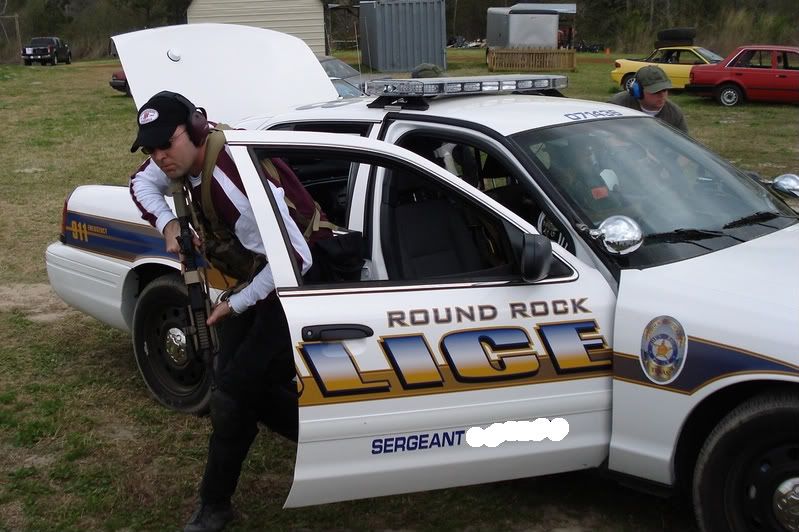 The author exiting the vehicle to provide cover for the rescue team.
The author exiting the vehicle to provide cover for the rescue team. The author assists in clearing a corner while the wounded officer is extracted.
The author assists in clearing a corner while the wounded officer is extracted. 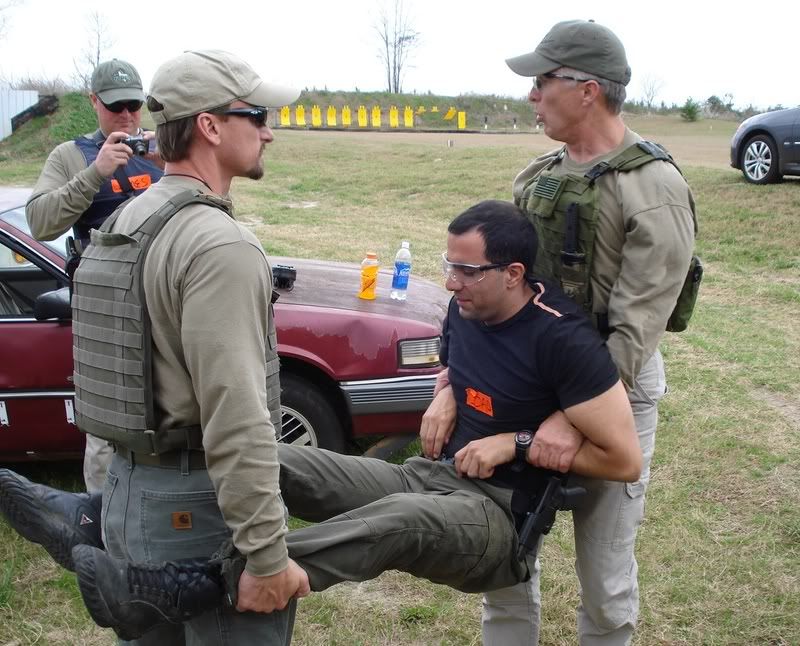 Claggett and McNamara demonstrating a “buddy carry” technique.CQB
Claggett and McNamara demonstrating a “buddy carry” technique.CQB CQB, or "Close Quarter Battle", simply means fighting within structures. Patrol officers find themselves checking residence and business alarms daily, and oftentimes find them open/unlocked or discover signs of forced entry. Walking through a residence assessing the loss after a burglary is one thing, making entry into a building while the burglar is still lurking about is quite another. CQB skills were expertly adapted to teams of two and three officers, and these teams were taught how to tactically make entry through various doors (breaching), move through hallways, and clear rooms.
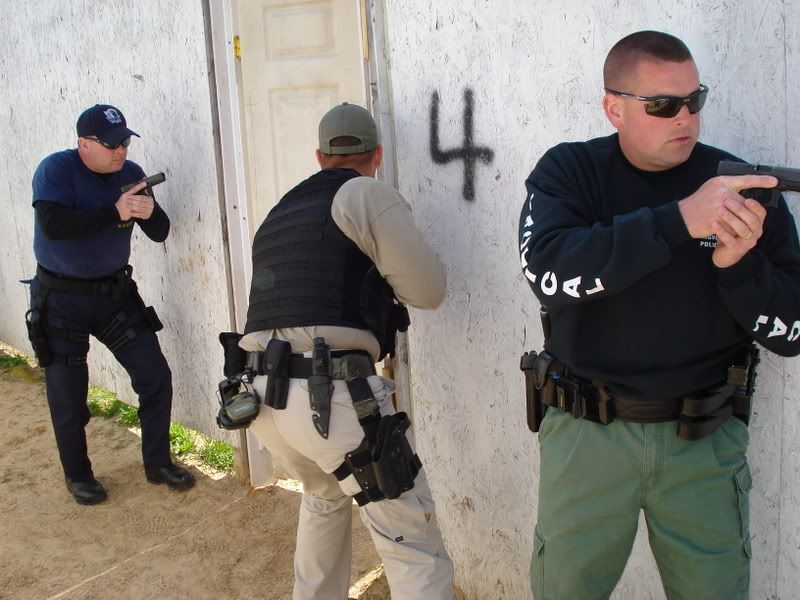 Students practice three-man breaching techniques with handguns.
Students practice three-man breaching techniques with handguns. Students practice two-man breaching techniques with rifles.
Students practice two-man breaching techniques with rifles. Students making entry into a room.
Students making entry into a room.The culmination of this training module had the teams making an approach to a breach-point, corner-clearing a hallway, and clearing multiple rooms, all under surgical rifle fire.
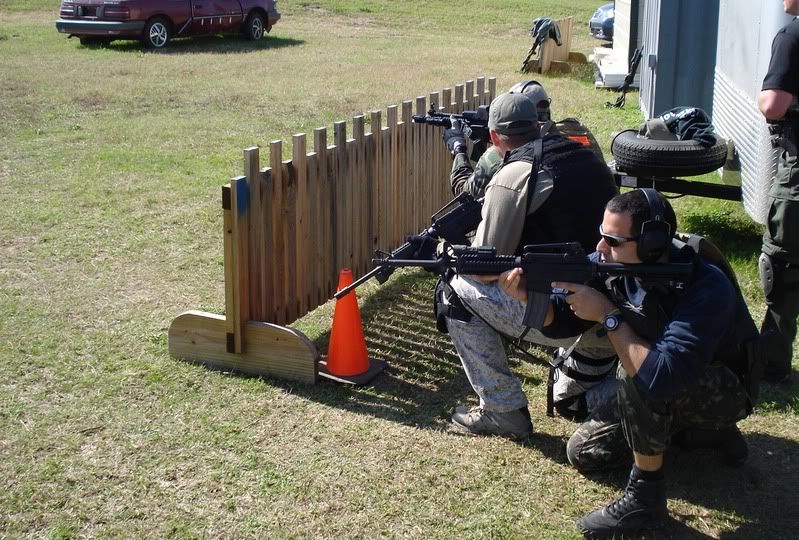 The three-man assault team prepares to hit the target.
The three-man assault team prepares to hit the target. A student provides surgical rifle fire while his element advances on the target location.
A student provides surgical rifle fire while his element advances on the target location. The first two elements of the three-man assault team pops a corner clear on the shoot-house. FIGHTING AROUND VEHICLES
The first two elements of the three-man assault team pops a corner clear on the shoot-house. FIGHTING AROUND VEHICLES Most germane to the patrol officers situation, was the fighting around vehicles training module. This training sequence took students from the front seat of a patrol car (where they spend many hours a day), and put them outside and around different cars, shooting targets from the front, rear and sides. Students practiced moving safely with a handgun in the "Sul" position, where the muzzle is pointed straight to the ground. Howe demonstrated the effects of various projectiles on car hoods, windshields, and doors, showing how bullets will glance off sheet metal at acute angles necessitating officers to keep a few feet off their cover. Additionally, students practiced communicating with others during a gunfight, and ingrained the need to look around before moving from a place of cover.
 Howe demonstrates where the officer should position himself to safely use a vehicle as cover.
Howe demonstrates where the officer should position himself to safely use a vehicle as cover.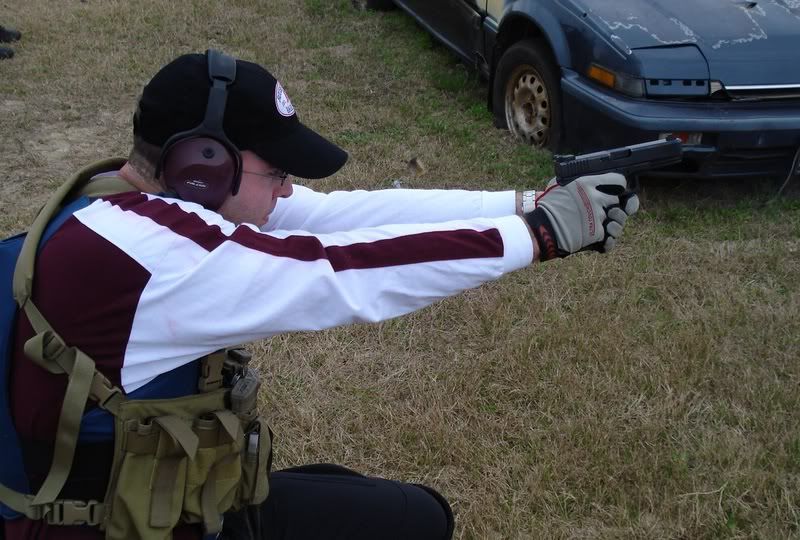 The author engages steel targets from behind a vehicle he is using as cover (not pictured.)
The author engages steel targets from behind a vehicle he is using as cover (not pictured.)  The author moves in the “Sul” position while another student provides cover.
The author moves in the “Sul” position while another student provides cover. A student scans for targets and waits for his partner to provide cover before he moves. Verbal and non-verbal cues were used to communicate when to move. “Silence is consent, gunfire is security” was one of the favorite sayings of the week. HIGH RISK VEHICLE TAKE-DOWNS
A student scans for targets and waits for his partner to provide cover before he moves. Verbal and non-verbal cues were used to communicate when to move. “Silence is consent, gunfire is security” was one of the favorite sayings of the week. HIGH RISK VEHICLE TAKE-DOWNS At the end of vehicle pursuits, the perp has either willfully stopped his vehicle, or has wrecked out. Rushing blindly up to the vehicle and pulling the suspect(s) out through the vent window may work in the movies, but in the real world we conduct high risk stops. However, what do you do if the perp refuses to cooperate, and stays seated instead of coming out? This new problem calls for the solution of the high risk vehicle take-down, or "vehicle assault." Students were trained in three and four person vehicle take-downs which enforced the need for officers to slow down at the end of pursuits, and not to rush into an ambush.
 A three-man assault team consisting of two cover officers and a breacher engage the target vehicle.
A three-man assault team consisting of two cover officers and a breacher engage the target vehicle. This particular class was treated with a surprise benefit. Howe had asked "Wing Chun" Kung Fu instructor Danny Flannigan to come and be a part of this class as an observer, in order to see and experience the tactical environment of today's law enforcement officer. Instructor Matt McNamara, a student of Flannigan’s, taught a special one-hour block of instruction during the week on the combative mindset, which shifted the author’s entire frame of mind concerning open-handed combatives.
Flannigan introduced the “soft palm” technique utilizing relaxed energy, and generally made himself available to the students "after hours" and one-on-one between training modules. The information and techniques presented by McNamara and ironed out by Flannigan added tremendously to the value of the class.
 Danny Flannigan stops for a picture with the author.
Danny Flannigan stops for a picture with the author. Howe briefed the class on medical emergencies, and presented a cheap and easy wound kit that was simple enough that each student could put together his own and take into the field. After presenting and demonstrating how to use the wound kit, Howe took the class through a very realistic mock medical emergency, and showed how easy it was to administer life-saving treatment.
 The aftermath of the training module shows the realism of the exercise. REVIEWS
The aftermath of the training module shows the realism of the exercise. REVIEWSI do not recommend trying out new gear at a class like this, however there are few better opportunities to wring out that new “tactical whizzit” and see if it's going to work. With this in mind, I brought along a few new items to test out, and furthered my testing on the rest of my gear.
While I have always used soft ear protection, I wanted to pick up some electronic muffs for this class. I did not want to miss out on any training insight (or banter) on the range, so I decided to pick up a pair of Peltors. Unfortunately, I was rushed before leaving for the class, and only had time to stop by Academy Sports to look for the Peltors. Academy did not carry them, so I settled for
Silencio Falcons instead. The Falcons had adjustable volume controls and were advertised to reduce loud sounds by 22 decibels, while amplifying soft sounds. After the first day on the range, I developed a splitting headache and decided to only turn on the speakers sporadically for the rest of the week. The Silencio Falcons (unlike the Peltors) do not have a wind sock over the microphones, and therefore produced quite a bit of wind noise. There were two very windy days, and I opted to just keep the microphones turned off. The Silencio Falcons cost $70. I am still in the market for a set of Peltors…
I was given the opportunity to try out a new line of undershirts that are made of spun nylon as opposed to polyester which is found in Underarmor and the rest. I received the samples (in white) from
Execwear shirts (www.execwearonline.com), and absolutely loved them. They performed exactly as advertised, keeping me absolutely dry by wicking perspiration into the outer garment. While the weather was not as hot as Texas can get in the summer, I wore soft body armor all week which definitely can give a shirt like this a workout! At the end of the day, my shirt came off dry, which was enough to impress me. I will be looking to buy a set of these shirts in black for use on duty very soon.
I ran
Magpul P-Mags exclusively all week in my rifle. This is not the first time to use these mags, but it was nice to see the previous testing confirmed by the 100% reliability of these magazines. They worked flawlessly with my Lula magloader, which is possibly the best piece of gear I have ever purchased for $24. The best feature of the magazine, is its ability to effortlessly lock into a rifle with a closed bolt, even when loaded to 30rds (no need in downloading to 28rds.) I carried the magazines in an Eagle chest rig, which puts the magazines between the shooter and the ground when shooting from the prone position. This can play havoc on lesser magazines, but I felt very confident each time I reached for a fresh mag, knowing the extreme durability of the P-Mag. Magpul P-Mags typically cost $14.95 locally, and are widely available on the internet. P-Mags come in black, Flat Dark Earth (tan), and Foliage (green.)
When it came time to pick a rifle to take, I chose my
LWRC M6A1. I have the 10.5” barreled version, and ran it without a suppressor for the class. The rifle is a short-stroke gas piston operated carbine in 5.56NATO and is otherwise identical to an AR-15. I cleaned it after the first day of shooting, then left it alone for the remainder of the week. It functioned perfectly, never missing a beat. Another student brought his 10.5” LWRC rifle in M6A2 configuration. He did not experience any issues either with his rifle, and shot it both with and without the AAC Scar suppressor.
 LWRC M6A2 and M6A1 being carried by students in the class.
LWRC M6A2 and M6A1 being carried by students in the class.Paul Howe is currently endorsing LWRC publicly, and has appeared in advertisements to this effect. Howe is working with LWRC to develop an official CSAT carbine, which will feature special engraving as well as accessories to Howe’s specs.
 Instructor Paul Howe pictured with the author.
Instructor Paul Howe pictured with the author. All in all, I am thoroughly pleased with the level of training I received at CSAT, and would recommend both Paul Howe and his facility to anyone looking for the next step in their training.
 Win a FREE Membership!
Win a FREE Membership!